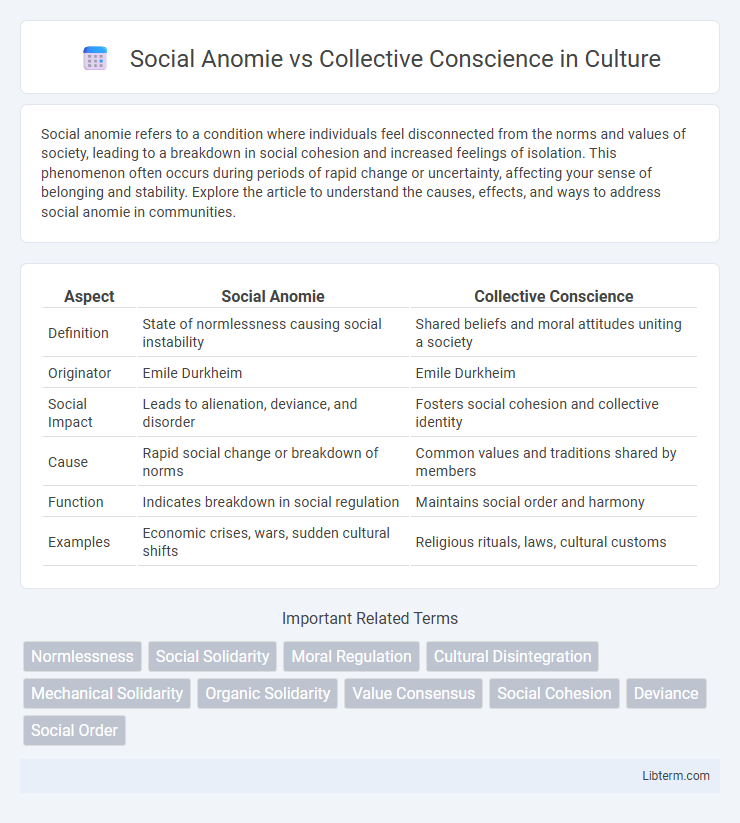Social anomie refers to a condition where individuals feel disconnected from the norms and values of society, leading to a breakdown in social cohesion and increased feelings of isolation. This phenomenon often occurs during periods of rapid change or uncertainty, affecting your sense of belonging and stability. Explore the article to understand the causes, effects, and ways to address social anomie in communities.
Table of Comparison
| Aspect | Social Anomie | Collective Conscience |
|---|---|---|
| Definition | State of normlessness causing social instability | Shared beliefs and moral attitudes uniting a society |
| Originator | Emile Durkheim | Emile Durkheim |
| Social Impact | Leads to alienation, deviance, and disorder | Fosters social cohesion and collective identity |
| Cause | Rapid social change or breakdown of norms | Common values and traditions shared by members |
| Function | Indicates breakdown in social regulation | Maintains social order and harmony |
| Examples | Economic crises, wars, sudden cultural shifts | Religious rituals, laws, cultural customs |
Defining Social Anomie: Origins and Key Concepts
Social anomie, a concept introduced by Emile Durkheim, refers to a state of normlessness where societal norms and values become unclear or erode, leading to social instability and individual disorientation. It originates from Durkheim's studies on the impact of rapid social change and modernity on traditional social structures, emphasizing the breakdown of collective norms that regulate behavior. Key concepts include the loss of social cohesion, weakened moral guidance, and increased deviance, contrasting sharply with Durkheim's notion of collective conscience, which represents shared beliefs and moral attitudes that unify society.
Understanding Collective Conscience: The Backbone of Social Solidarity
Collective conscience refers to the shared beliefs, values, and norms that unify members of a society, fostering social solidarity. It functions as the moral framework that guides individual behavior and maintains social order amidst diversity. Understanding this concept is crucial for analyzing how social cohesion persists despite the presence of social anomie, a state of normlessness and disintegration.
Historical Roots: Durkheim’s Influence on Both Concepts
Emile Durkheim laid the foundational framework for understanding social anomie and collective conscience by exploring the effects of societal change on social cohesion in the late 19th and early 20th centuries. His analysis in works like "The Division of Labour in Society" and "Suicide" links social anomie to the breakdown of traditional norms during rapid industrialization, while collective conscience represents the shared beliefs and moral attitudes that unite members of a society. Durkheim's insights emphasize the tension between individual autonomy and social integration, shaping ongoing sociological discussions on social order and disintegration.
The Individual vs Society: How Anomie and Collective Conscience Differ
Social anomie represents a state where individuals experience a breakdown in the social norms and values that guide behavior, resulting in feelings of isolation and normlessness. Collective conscience refers to the shared beliefs and moral attitudes that bind individuals together, creating social cohesion and a sense of belonging within a society. While anomie emphasizes the disconnection of the individual from societal norms, collective conscience highlights the integration and unity between the individual and society.
Causes and Consequences of Social Anomie
Social anomie arises from the breakdown of social norms and values, often caused by rapid social change, economic instability, or weakened social institutions. This normlessness leads to social isolation, increased deviance, and higher rates of crime and suicide, reflecting the disintegration of collective conscience. The erosion of shared beliefs reduces social cohesion, resulting in weakened social bonds and diminished community solidarity.
The Role of Collective Conscience in Maintaining Social Order
Collective conscience encompasses the shared beliefs, values, and norms that bind individuals within a society, serving as a crucial mechanism for maintaining social order by promoting conformity and cooperation. Social anomie, characterized by a breakdown of these shared norms, leads to social instability and increased deviance. Emile Durkheim emphasized that a strong collective conscience fosters social integration and prevents the disintegration associated with anomie.
Social Change: When Collective Conscience Weakens and Anomie Rises
Social change often triggers the weakening of collective conscience as shared norms and values dissolve, leading to increased social anomie characterized by normlessness and disintegration of social cohesion. Durkheim's theory explains that during rapid societal transformations, such as industrialization or technological shifts, the regulatory function of collective conscience declines, causing individuals to experience confusion and alienation. This rise in anomie results in higher rates of deviance, social instability, and a breakdown of community bonds, emphasizing the critical role of renewed collective conscience in restoring social order.
Modern Examples of Anomie in Contemporary Society
Social anomie manifests in contemporary society through phenomena such as rising mental health issues, increasing social isolation, and weakened community ties due to rapid technological changes and economic disparities. The decline of shared norms and values, exemplified by political polarization and diminished trust in institutions, highlights the erosion of Durkheim's collective conscience. Urban environments with high unemployment rates and fragmented social networks are prime examples where anomie disrupts social cohesion and collective identity.
Collective Conscience in Practice: Community and Cultural Cohesion
Collective conscience manifests in practice through shared values, norms, and beliefs that foster community solidarity and cultural cohesion. This social integration reinforces mutual trust, cooperation, and a sense of belonging, which counteracts social anomie -- the state of normlessness and social instability. Institutions, rituals, and traditions play crucial roles in maintaining collective conscience by aligning individual behaviors with community expectations.
Bridging the Gap: Strategies for Balancing Individualism and Social Unity
Strategies for balancing individualism and social unity involve fostering a dynamic interplay between social anomie and collective conscience, emphasizing shared values that accommodate personal freedoms while promoting community cohesion. Implementing inclusive dialogue platforms and participatory governance can mitigate the alienation caused by social anomie, reinforcing collective conscience through mutual respect and common goals. Educational reforms that highlight both individual rights and social responsibilities further bridge this gap, cultivating a society where diversity and unity coexist harmoniously.
Social Anomie Infographic

 libterm.com
libterm.com